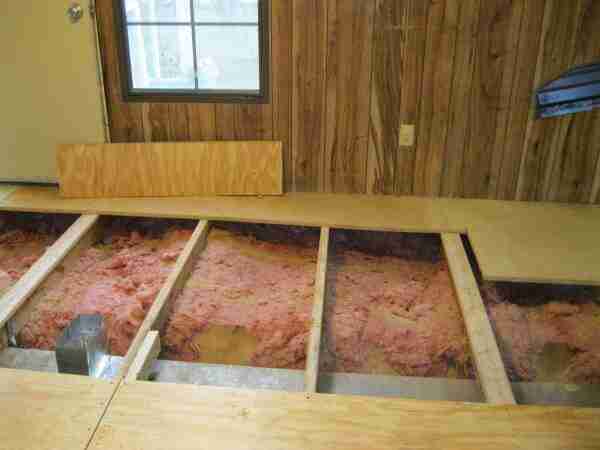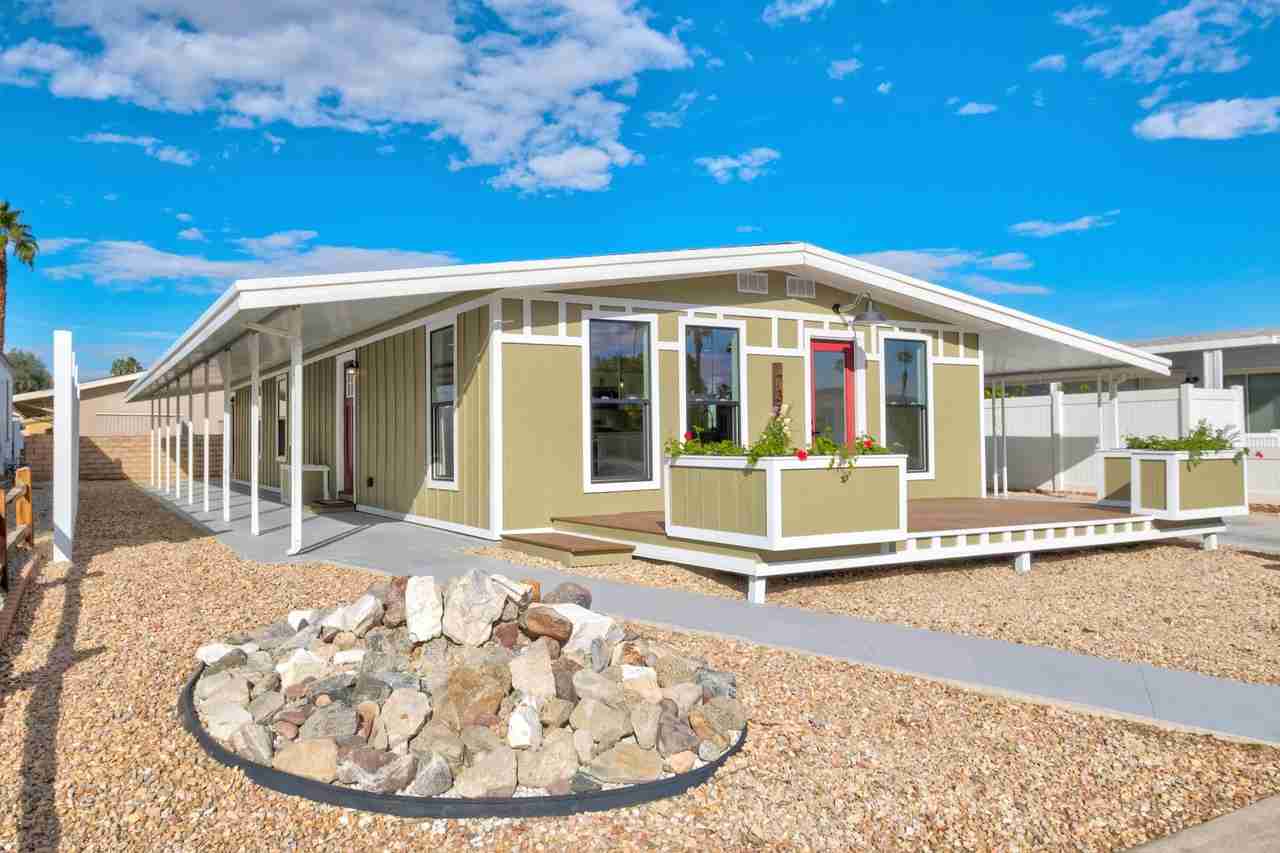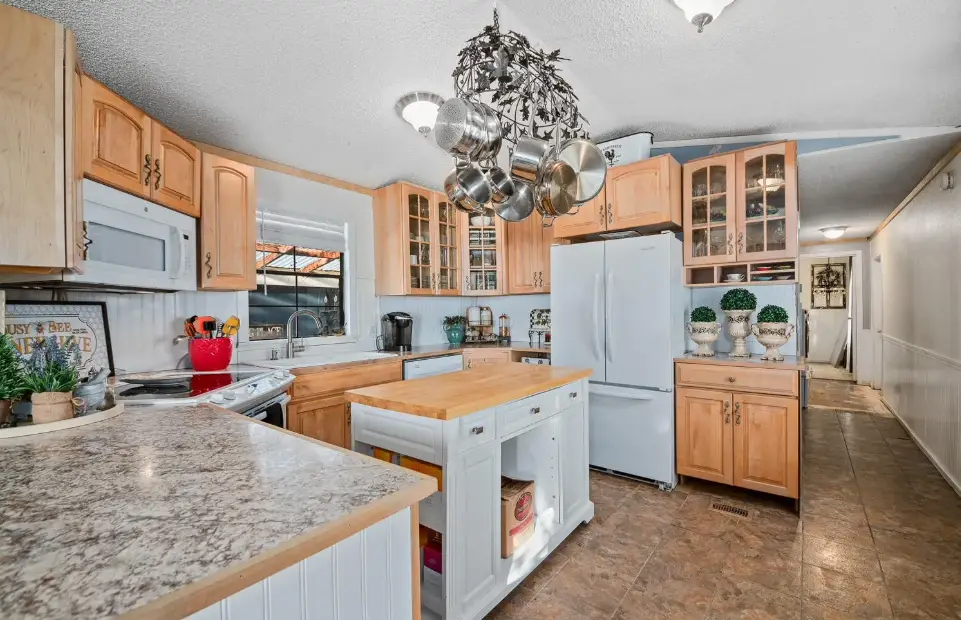When the leaves start turning pretty colors and football is in full swing it’s time to winterize your mobile home.
Older mobile homes have poor insulation compared to homes built today. Energy efficiency experts say that if your mobile home is over 30 years old you need to add insulation to the floors, walls, and ceiling and install new doors and windows. But most of us don’t have the money to do that (at least I don’t). Like most people, I can only afford to do a few small improvements and updates to help reduce winter heat loss. These 7 tips to get your mobile home ready for winter don’t cost a lot and are fairly easy to do.
Every little bit of heat that you can keep inside your home is going to help your comfort and your wallet. By winterizing your mobile home you can reduce heat loss and save money.
Here are a few tips to help you winterize your home and save money.
Loosen the Tie-Downs
If you live in an area where the ground freezes solid, it’s suggested to slightly loosen your mobile home’s tie-downs. Frozen ground can shift as much as three inches during the winter which is called ground heave.
When properly installed, tie-downs are taut and leave no room for a manufactured home to move. If the ground does shift it can cause serious structural damage.
When winter is over, remember to tighten tie-downs again in the spring. Learn more about tie-downs here.
Check the Skirting Vents
Mobile home skirting must have 1 square foot of ventilation for every 150 square feet of floor space (or living space). These vents need to be placed within 3-foot of each corner to reduce dead air pockets that occur in the corners under the home. In the summer, the vents will be open so that air can continuously circulate under the home.
In the winter, you want to stop the cold air from circulating under your home so you will need to close the vents. You can buy automatic vents that open and close based on the temperature for around $20 (but that can add up if you have 10 vents).
Check the skirting on your mobile home. It should be secure but not too tight that it completely stops ventilation. You must have a little bit of ventilation in your skirting even during the cold winter months (you’ll be closing the vents).
Carefully examine your exterior siding and replace any missing or damaged fasteners or screws. Once winter arrives, make sure to shovel snow and ice away from skirting so it doesn’t get dented, which will cut off the air supply required by the furnace.
If you could add foam board behind your skirting you could create a homemade insulated skirting. Insulated skirting has an R-Value of 2.7 compared to regular vinyl skirting’s R-Value of 2.0. One handy couple used foam board to seal under their mobile home flooring here.
Inspect Your Furnace
Take a closer look at your furnace, inspecting the blower motor and vacuum any accumulated dirt. Check the exhaust vent going out the roof and the intake vent in the floor, door, or wall. Clear any debris from the vent pipe and be sure to keep the roof exhaust vent clear of excess snow build-up.
Most manufactured home furnaces draw combustion air from beneath the home, so it’s suggested to keep four to six vents in the skirting to allow free air passage. Experts recommend one square foot of vent for every 150 square foot of floor surface. You’ll also want to ensure your furnace has the right amount of intake for the blower – you need at least 2 square inches of return air area for every 1000 Btuh of furnace capacity.
Learn more about mobile home furnaces and heat pumps here.
Seal Your Outlets
Windows and flooring are the biggest heat losers in a home. Believe it or not, your electrical outlets are big heat losers too. It is a hole in your wall so I guess it makes sense, especially if your mobile home doesn’t have an exterior sheathing.
Cracked sockets are even bigger heat losers. You can buy insulation boards or pads to install behind your sockets but caulk can work too. The idea is to close or seal off any holes or cracks that allow air to enter or exit the home. Whether it’s as big as a door or as small as an outlet.
Take off the electrical plate and reseal the inside with a caulk to make sure no heat is escaping to the outside.
Related: Guide to Mobile Home Insulation
Check Your Ceiling Fans
Ceiling fans need to run clockwise in the winter to push warm air down.
Seal Your Chimneys and Fireplaces
Chimneys and fireplaces that are not properly sealed can allow cold air in and warm air out. If you never use your fireplace it may be a good idea to go ahead and seal it off. If you use it only a few times each year a rubber-sealed damper can help.
The glass doors on modern fireplaces aren’t just decorative. Besides keeping embers off the carpet, doors can help seal the fireplace a bit. You can add a fireproof seal around the edges of the door too. Every little bit helps!
On the other note, you can use wall mounted fireplaces. Wall-mounted fireplaces are usually easy to install and can be hardwired or just plugged into an outlet. You don’t have to cut a hole in your wall if you don’t want to – many models can hang on the wall. They come in many styles such as a minimal sleek look or a more traditional style. Here you can check the best electric fireplaces (according to Brian Simpson of Topratedfireplaceinserts.com).
Exterior Water Heater Closets
Water heaters and their exterior closets need to be insulated. There are specially insulated jackets or covers you can buy for water heaters. You can also add foam or insulation around the closet walls, ceiling, and door to keep the heater from working double-time to keep water warm.
Do Furnace Maintenance
Furnace filters should be replaced regularly. If you use permanent filters you’ll want to clean them often with a brush or vacuum and soapy water.
Make sure the area around your furnace is clean. Remove out any debris in the furnace area and prevent small amounts of dirt, dust, or clothing from accumulating. Never use your furnace closet for storage or drying clothes.
Seal Doors and Windows
Check interior and exterior doors for wear and tear on the frame or seals. Look for signs of leaking around both the sill and threshold. Check that weather stripping and seals are intact. The vinyl weather seal is suggested to seal any leaks around the frame.
If you live in a colder climate, make sure your doors can handle the winter season. Consider investing in new doors.
The past couple of winters have broken records and caused several billion in damage to homes so it’s important to winterize your mobile home. Hopefully, you can get your mobile home ready for winter with these tips.
Thank you so much for reading Mobile Home Living!







For the hot days, I bought white blackout fabric and made flat panels that I hook up on our big west and south facing windows. The fabric is fairly light weight and doesn’t need to be hemmed or zigzagged or anything, just cut to size. Huge difference in summertime climate control. Will be testing them on the freezing cold days (here in Michigan, we have both) and I expect comparable results in retaining heat. Cheap and easy.
Changing the skirting is the hardest
I’m thinking of changing to cement panels
Has anyone else used these and have advice
Hi Tena!
It's smart to be a nerd..lol! You just saved a lot of money! I've seen a couple of HUD things about mobile homes, they are very informative. I'll have to look into the one about retro-fitting the homes. Thanks for sharing your tip!
Crystal
HUD put out a tremendous document for retrofitting older mobile homes for safety and energy savings. It's fabulous!
Personally, for instance, I put up a plantation wood blind over the window on the sunny side of the home and it made an 11-degree temperature difference inside! Yeah, I am a nerd. I track things like that.
The best window covering would have been those fabric blinds that have a geometric configuration so there is a layer of air between. (can't think of the name of them but you can see them in the blinds area in any of the big box home stores.) They are pricier than I wanted to spend and preferred the look of the wood.
M